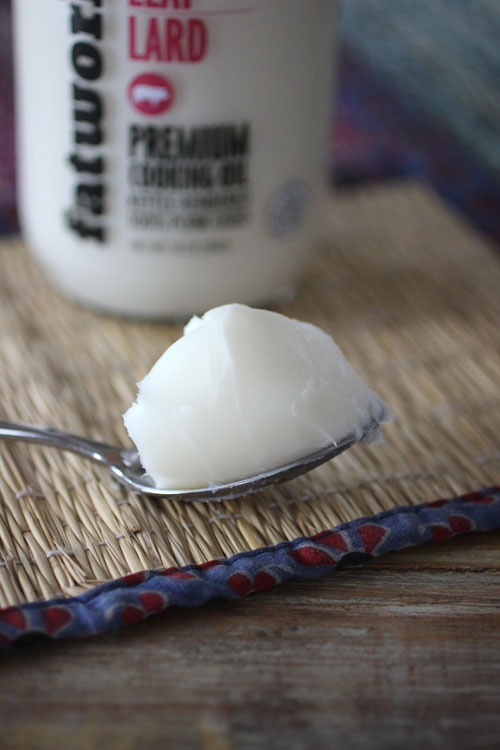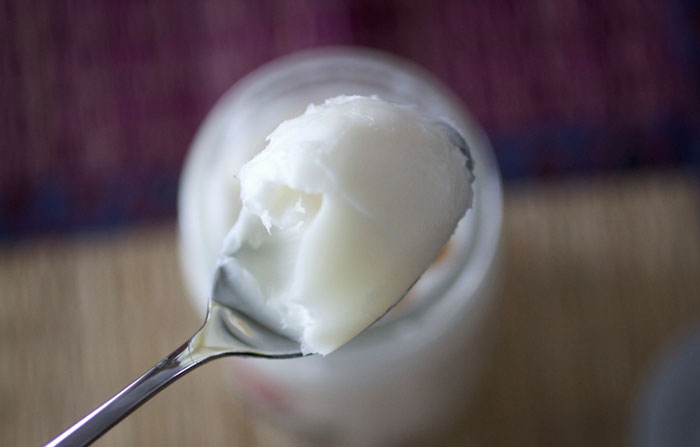Have you ever tasted a perfectly-browned, flaky pie crust made with lard? Have you enjoyed the slightly crisp and wildly flavorful goodness of fresh veggies sauteed in pig fat? Have you dared to slather a creamy, delicious spoonful on a slice of sourdough bread? If you answered no to any of these questions, you are missing out. Lard (rendered pig fat, that is) was once a staple in the traditional kitchen—and with good reason. This delectable fat not only tastes divine, but it might also have you wondering: is lard a healthy fat? The answer may surprise you.

What is Lard Anyway? What Is Cooking Lard Made From?
What is cooking lard? Simply put, cooking lard is rendered pork fat. It is created by slowly heating fatty cuts of pork to draw out the fat and evaporate water. The pure white fat that remains is what we know and love as lard.
Leaf lard is considered the most pristine type, made only from the “leaf” of the pig—protective deposits of 100% pure fat. Since there's no muscle tissue in this section, it offers a milder pork flavor than standard lard. 1
A Staple in Traditional Kitchens
Lard of all types was once a cornerstone in the American kitchen. Before the rise of commercial oils, lard was the go-to fat for baking, roasting, and frying. Pantries didn’t hold bottles of expensive olive oil, nor did they stock jugs of canola oil. Instead, they were lined with hearty, nutrient-dense lard—an affordable, local, and sustainable fat made from pigs raised on small farms. Why is lard good for you? In part, because it aligned with traditional, whole-animal food values.
The Mysterious Disappearance of Lard
So what happened to this beloved fat? This questions has been the subject of several fascinating investigations in recent years, including the popular NPR segment entitled Who Killed Lard? To summarize, the case of lard seems to be a classic example of commercialism and food marketing gone wrong.
Some of the blame for lard's demise has been placed on Upton Sinclair, the author and journalist who released the muckraking novel The Jungle in 1906. His provocative book highlighted the unsanitary practices used in the large-scale American meatpacking industry during the early 20th century. Within its pages sits an unforgettably gory passage on the anecdotal dangers of manufacturing mass quantities of lard (I will let you Google that one on your own if you want to read it in full...). On the positive side, Sinclair's book helped to bring about the first food safety and labeling laws in the United States. Unfortunately, the novel also spurred an unfounded panic about the use of lard in everyday cooking. "I aimed at the public's heart," Sinclair said, "and by accident I hit it in the stomach." 2
Capitalizing on this unintended hit to lard's reputation, the vegetable shortening Crisco appeared on the shelves with a bang in 1911. This lab-made oil was created from the cottonseed oil surplus that was left over from the failing candle-making industry. Struggling to revive their business, Procter & Gamble (then a candle and soap-making duo) turned their excess liquid cottonseed oil into a shortening that very closely resembled lard. This was done through the process of hydrogenation, which involves altering the structure of liquid fats to make them solid.
Recognizing that their livelihoods depended on this new product, the company did everything they could to market this synthetic cooking fat to the masses. This was a tall order, especially since cotton barely passes as a food; but the pair were relentless. "It's all vegetable! It's digestible!" became the slogan of the times. Crisco cookbooks filled with propaganda-style recipes were distributed, and free samples were sent to schools and hospitals in bulk. Lard was rapidly displaced in favor of this supposedly “superior” man-made alternative. 3
Is Lard a Healthy Fat? Here's What Science Says
The decline didn’t stop there. By mid-century, medical experts began warning against saturated fats altogether. For more than four decades, these traditional lipids were blamed for high cholesterol and rising rates of heart disease in the West. But today, newer research is calling those claims into question. One comprehensive analysis of 21 studies found no clear link between saturated fat intake and coronary artery disease. Several more recent reviews have reached similar conclusions. 4, 5, 6
We also now understand that the hydrogenation process used to create Crisco and other industrial fats produces trans-fats—compounds now strongly linked to inflammation, cancer, heart disease, and other chronic illnesses. As a result, legislation is now in place to phase them out of all food products. 7
It’s striking to realize that both the public and health professionals were led astray by decades of food industry marketing. Many of the health challenges we face today can be traced back to large-scale industrial food production. And now, as we look for answers, we’re finding that the “new” way forward may actually be rooted in traditional wisdom.
Lard, once dismissed, is being rediscovered as a healthy fat for cooking—rich in nutrients, naturally stable at high temperatures, and completely real. As more people question is lard a healthy fat, the science and history both point to the same answer: it’s time to bring lard back to the kitchen.

3 Reasons to Love Lard
1. Lard is Rich in Healthy Fats
You read that heading correctly: the words 'healthy' and 'fat' happily co-existing in the same phrase! On this blog, we are passionate about bringing traditional fats back into the kitchen. Rich, whole fats are required to support many biological processes in the body. Specifically, fatty acids are needed to prime the nervous system, produce hormones, and encourage optimal digestion.
Lard contains a beautiful balance of saturated and unsaturated fats, at about 40% saturated, 50-60% monounsaturated and up to 10% polyunsaturated fats. For perspective, that is about 1/4 of the saturated fat and 2 times the monounsaturated fat as butter. Next to extra virgin olive oil, lard contains the highest quantity of coveted monounsaturated fats of any cooking oil. It is also concentrated in healthy omega-3 fatty acids, while remaining low in the inflammation-promoting omega-6s.
So, is lard healthier than butter? In many ways, yes—especially when it's sourced from pastured animals. 8
2. Lard Contains Vitamin D
These days, everyone is scrambling to get more vitamin D, too. Nicknamed the sunshine vitamin, this nutrient is in high demand, especially as our modern lifestyles drive us to spend more time hunkered down inside in front of computer screens. Vitamin D is produced by the body in response to the skin being exposed to the sun. It also occurs naturally in select foods including fish, fish oils, egg yolks and yes, you guessed it: lard.
The recommended dietary intake of vitamin D specified by the Institute of Medicine (IOM) has long been 600 IU/day through age 70 years, and 800 IU/day for older ages. However a series of recent studies by researchers out of UC San Diego and Creighton University have shown that these doses are as low as one-tenth those needed to cut incidence of disease related to vitamin D deficiency. In other words, the human body needs far more vitamin D than was once thought to maintain healthy bones, a well-running immune system and an optimal functioning cardiovascular system.
Luckily, lard contains this prized nutrient, with some experts stating that it is the richest food source of vitamin D behind fatty fish and cod liver oil. Vitamin D is also a fat-soluble nutrient, meaning that the body requires adequate amounts of fatty acids to metabolize it. Lard, therefore, delivers vitamin D with the necessary co-factors to assimilate it, all in one delicious spoonful! Keep in mind that this feature is unique to lard from free-range, pastured hogs that are raised with exposure to sunlight and fed a rich, greens-based diet. 9, 10
3. Lard Tastes Good
Now that we have some of the more science-y reasoning out of the way, we can get down to the most important aspect: taste. Foods cooked in lard simply leave the pan tasting delicious! The neutral flavor makes lard suitable for sweet and savory dishes alike, and it won't overpower a meal as other fats like coconut oil can. Lard has a high smoke point at around 370°F or so, and it thus remains stable at high temperatures. With all of these admirable qualities, it is really no wonder that the fat has been making a serious comeback in restaurants too.
Chefs across the United States are joining what has been playfully dubbed the "lardcore" movement. The best way for you to understand this point of course, is to try some lard for yourself! Be sure to find a source that is low-heat rendered and from pastured pigs to ensure that you are experiencing the full-range of nutritional benefits.
If you are feeling adventurous, try making lard the good old-fashioned way by following a recipe like this, or simply render it in a crock pot. If you decide to try some out before committing to the process of making it, I highly recommend these authentic pastured lards from Fatworks.
